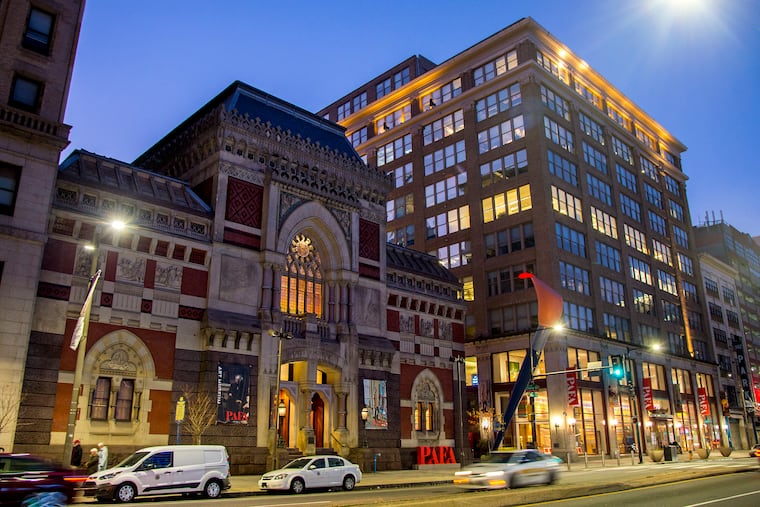Art majors struggle with high debt, low pay — especially at PAFA | Does that Degree Pay?
Right out of PAFA, a graduate with a master’s in fine arts owed $93,008 in federal student loans and earned just $20,900 a year, according to a new Inquirer database.

On Feb. 21, the Pennsylvania Academy of the Fine Arts hosted its annual open house. Visitors nibbled on cheese squares and grapes. Noses tingled from paint smells in the artists’ studios on the eighth floor. “Lovely” was a common refrain from visitors looking at student art.
But one thing not much discussed on that upbeat night was the scourge of PAFA graduates and those of other art schools: student debt.
Graduates of the master’s program in fine arts at PAFA, the nation’s oldest art school with $120 million in assets, had the highest student debt-to-personal-income rate in the region, a trove of recently released federal data shows.
The records detail graduates’ median earnings one year later and their federal student debt, broken down by degrees and colleges. It all can be searched on a new Inquirer tool that includes 3,460 colleges and post-secondary training programs in Pennsylvania, New Jersey and Delaware.
Right out of PAFA, a graduate with a master’s in fine arts owed $93,008 in federal student loans and earned just $20,900 a year, The Inquirer’s tool shows.
Not only did those PAFA master’s graduates stagger under the highest debt-to-income ratio in the three-state region, it carried the third-highest ratio in the nation for the same degree, according to the national data. The other master’s of fine arts in the top five: the New York Academy of Art in Tribeca; Academy of Art University in San Francisco; Pratt Institute in Brooklyn, and the University of Pennsylvania.
The Penn fine arts masters graduated with a median federal debt of $86,257, while earning a paycheck of $21,700.
“I don’t know where the money goes,” said a PAFA student contacted after the open house and who asked that her name not be used because she’s still enrolled there. “We don’t even have a meal plan.”
Art careers are notoriously elusive.
PAFA has created two new majors, illustration and animation, which “can offer a more defined career path in the contemporary job market than other traditional areas of study in the fine arts,” said Clint Jukkala, dean of the School of Fine Arts.
PAFA said it realizes that art schools are expensive. To help students, the institution has added millions for scholarships over the last decade for a total now of $5 million a year, Jukkala said. As a result of PAFA’s scholarship programs, 28 PAFA students are paying no tuition this year, representing more than 10% of PAFA’s undergraduate and graduates, the institution said.
.
PAFA’s career services department advises students on personal finance, budgeting, career-path development, competing for contracts and other opportunities, resume development, self-promotion, and other essential career skills, the school said.
This year, about one-third of PAFA’s students graduating with a master’s in fine arts will leave without debt, and slightly more than half of the bachelor’s in fine arts will also graduate without student loans, the arts school said.
In 2016, the average national federal student loan default rate was 10.1% while PAFA’s rate was 2.7%, Jukkala noted, putting the "institution significantly below the national average and lower than any of the colleges of art and design that PAFA views as peers.”
Robert Kelchen, associate professor at Seton Hall University, said that default rates are “not a good measure of a student’s ultimate outcome because students can avoid default by enrolling in an income-driven repayment program” that let graduates with low-paying jobs cut their monthly payments. Then, after 20 years of payments, the federal government can forgive the taxpayer-backed loan. "Avoiding the worst possible outcome of default is important, but it doesn’t mean that a student is doing well,” Kelchen said.
Art and liberal arts majors generally fared poorly in the government data that tracks degrees and earnings and debt. But experts say that students may not be pursuing those degrees solely for the immediate financial return and could transition to other more lucrative occupations later in their career.
“We have to consider that there is a payback of earnings over a lifetime,” said Laura Perna, a professor of education at the University of Pennsylvania and an expert in college affordability.
“So the value of a college education will be realized over a career because of the types of skills and critical thinking one learns in college,” she said. “We have to pay attention to other benefits in addition to earnings.”
Another factor in art schools is the expansion of for-profit institutions that have stocks traded on Wall Street. They expanded dramatically in recent decades, offering alternatives to traditional nonprofit colleges such as PAFA, Penn and Temple. But for-profit colleges have drawn the attention of state and federal investigators for predatory, or misleading, marketing and lending to students.
For bachelor’s degrees in fine and studio arts, the for-profit Art Institute of Philadelphia and the Art Institute of Pittsburgh had the worst federal debt-to-earnings ratios.
Both were part of the Dream Center chain of schools. The Philadelphia campuses closed in 2018 and the Pittsburgh campus closed last year.
James Brawner 3rd, 47, graduated from the Art Institute of Philadelphia in 1999 with about $38,000 in federal debt but he couldn’t land a job with his associate’s degree in visual communications and deferred his loan payments.
Over the years, he has worked as a security guard, customer service rep, and overnight stocker at Lowe’s. He complained about his rising debts to the state and federal education departments, city officials, former U.S. Rep. Chaka Fattah and the attorney general, but said no one responded.
His federal loan now stands at $114,000.